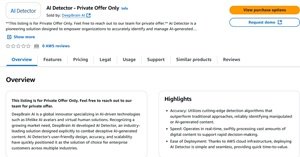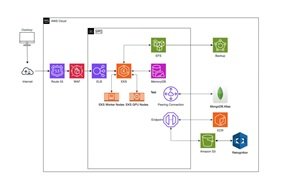Education
What is an apprenticeship and how do you get one?


 Getty Images
Getty ImagesStudents getting their A-level, T-level or BTec grades on Thursday may well be considering an apprenticeship as an alternative to university.
Minimum wages for apprentices went up in April.
But, with dropout rates at about 50% and concern about low pay, there is a lot to consider when weighing up whether or not it is for you.
What is an apprenticeship?
Being an apprentice means you usually spend four days a week working, and one day studying for a qualification at work, college, university or online.
You get paid and the qualification you get is free – it is paid for by the government and your employer.
Since last April, the government has paid small companies the full cost of apprenticeships for people aged 21 or under to help small businesses create more apprenticeships.
Any employer can hire apprentices. They are responsible for making sure you work with experienced staff and receive time off for studying.
In England, Wales and Northern Ireland, the different levels of apprenticeship are:
- Intermediate (Level 2 – GCSE standard)
- Advanced (Level 3 – A-level standard)
- Higher (Levels 4, 5, 6 and 7 – foundation degree or above)
- Degree (Levels 6 and 7 – bachelor’s or master’s degree)
In England, only 16 to 21-year-olds and existing apprentices will qualify for funding for level 7 apprenticeships from January.
In Scotland, they are:
- Foundation (mostly SCQF Level 6 – Highers standard)
- Modern (mostly SCQF Levels 6 and 7 – Highers or Advanced Highers standard)
- Graduate (SCQF Levels 9, 10 and 11 – undergraduate or master’s degree standard)
How much are apprentices paid?
If you are under 19, or if you are 19 or older but in the first year of your apprenticeship, you will be paid the apprentice rate, £7.55 per hour.
Otherwise, you will earn at least the minimum wage:
- £10 for 19 and 20-year-olds
- £12.21 for those aged 21 or above. This rate is also known as the National Living Wage
Who does apprenticeships?
People often do apprenticeships if they know the career they want, or if they are already working in their chosen career but want more skills.
There are no UK-wide figures for the number of apprentices, but there were 736,500 in England last year.
Advanced apprenticeships – A-level standard – are the most popular, and the number of people doing higher apprenticeships has been rising.
In the 2023-24 academic year, 23% of new apprentices were under 19.
How to get an apprenticeship
If you know where you want to work, you can head straight to the employer’s website and apply.
You can search for apprenticeship opportunities through different official websites in England, Scotland, Wales or Northern Ireland. If you are in England, you can make an account and apply to several apprenticeships in one place.
The Universities and Colleges Admissions Service (Ucas) allows you to search for vacancies and plans to allow you to apply for them.
You will interview for the apprenticeship before you start, and you will need to pass an assessment showing what you have learned before you can finish.
The most popular apprenticeships for new starters in 2022-23 were in health, public services and care – followed by business, administration and law.
Some of the biggest employers of new apprentices in England in the financial year 2023-24 were the British military, the civil service, and the pub and restaurant group Mitchells & Butlers.
Are there downsides to apprenticeships?
In England, 60.5% of apprentices completed and passed a final assessment in 2023-24.
The previous Conservative government had aimed for that to reach 67% by this year.
A Department for Education report in March 2022 suggested that four in 10 people who did not complete their apprenticeship cited personal reasons, including career changes, mental health issues and caring responsibilities.
However, about four in 10 also said they were not given enough time for training, that the training did not meet their expectations, or that the apprenticeship was badly run.
Ucas has warned that young people are being put off by a range of barriers, including:
- low pay
- lack of availability
- having to apply for apprenticeships individually, rather than sending off one application to several employers.
In February, the government relaxed the rules for apprentices over the age of 19 by allowing businesses to decide whether a maths and English qualification should be part of the prescribed course.
It also confirmed plans to reduce the minimum duration of an apprenticeship, from 12 months to eight months, from August 2025.
How do I know if an apprenticeship is right for me?
Think hard about what the apprenticeship offers – will the qualification help you progress in the career you want? Can you picture yourself in a job in the industry? What opportunities are there to progress at the organisation itself?
You will want to consider where the apprenticeship is, how much you will get paid, and how long it lasts.
It is important to do your research, and ask employers for details about training in your interview. You can also read reviews of apprenticeships on sites like RateMyApprenticeship.co.uk.
Education
Google Advances AI Image Generation with Multi-Modal Capabilities — Campus Technology
Google Advances AI Image Generation with Multi-Modal Capabilities
Google has introduced Gemini 2.5 Flash Image, marking a significant advancement in artificial intelligence systems that can understand and manipulate visual content through natural language processing.
The AI model represents progress in multi-modal machine learning, combining text comprehension with image generation and editing capabilities. Unlike previous systems focused primarily on creating images from text descriptions, Gemini 2.5 Flash Image can analyze existing images and perform precise modifications based on conversational instructions.
Technical improvements include enhanced character consistency across multiple image generations, a persistent challenge in AI image synthesis. The system can maintain the appearance of specific subjects while placing them in different environments or contexts, indicating advances in computer vision and generative modeling.
The model leverages Google’s large language model knowledge base, allowing it to incorporate real-world understanding into visual tasks. This integration demonstrates progress toward more sophisticated AI agents capable of reasoning across different data types.
Google implemented safety measures, including automated content filtering and mandatory digital watermarking through its SynthID technology. The watermarking addresses growing concerns about the identification of AI-generated content as synthetic media becomes more prevalent.
The launch intensifies competition in generative AI, where companies including OpenAI, Adobe, and Midjourney are developing similar multimodal capabilities. Industry analysts view image generation as a key battleground for AI companies seeking to expand beyond text-based applications.
Gemini 2.5 Flash Image is priced at $30 per million tokens. For more information, visit the Google site.
About the Author
John K. Waters is the editor in chief of a number of Converge360.com sites, with a focus on high-end development, AI and future tech. He’s been writing about cutting-edge technologies and culture of Silicon Valley for more than two decades, and he’s written more than a dozen books. He also co-scripted the documentary film Silicon Valley: A 100 Year Renaissance, which aired on PBS. He can be reached at [email protected].
Education
AI in schools: Pros and cons of artificial intlligence in education

SYOSSET, New York (WABC) — Days before school returns, hundreds of teachers on Long Island listened and learned.
“We’re excited to be here to share some of the initial work that we were able to do with AI at the time of this pilot,” teacher Tyler Gentilcore said.
Gentilcore was among dozens of educators with the Syosset School District sharing their approach to teaching artificial intelligence in the classroom.
“It feels pretty cool to be on the forefront of something new like this,” he said.
Gentilcore teaches first grade at Robbins Lane Elementary School.
“They’re little so the pilot was really an opportunity for teachers to engage with different AI programs,” he explained.
Programs like Google’s Gemini are now being used by teachers in the classroom, including Syosset High School English teacher Caroline Polatsidis.
“It was just scary because I was worried that students wouldn’t be learning anymore, that they would be letting AI do the work for them, but now I see that we need to harness this great power,” Polatsidis said.
What about cheating? A recent study by the Pew Research Center found that a quarter of teenagers nationwide have used the app ChatGPT for schoolwork.
Most felt it was wrong to use the advanced AI to write essays and solve math problems.
“I actually think people here in this high school use AI to help them with their assignments, but in ways that our teachers actually condone,” NiKhil Shah, Syossett High School senior, said.
“We don’t have any other choice but to do it now. AI is moving at a pace. The world is moving at a pace faster frankly than we can educate our kids,” Syosset Schools Assistant Superintendent David Steinberg said.
It’s not just the teachers who are embracing using AI in the classroom. Many students are too.
“I really started to understand AI in high school as some of my teachers introduced it to me and kind of started to guide us on how to use AI,” Shah explained.
Shah said using AI in school was introduced last year in his Spanish class.
“We would record speaking in Spanish. In order to improve the way we spoke, we would submit it to AI. It would analyze it and show us where we made mistakes, where we could improve,” he said.
Some students are skeptical.
“Personally, I never really was a fan of AI just because of the environmental costs it has,” senior Janice Opal Kang said.
According to the United Nations, the growing number of data centers that house AI servers use massive amounts of electricity, spurring the emission of global warming greenhouse gases.
Back in the classroom, AI is not only transitioning in schools on Long Island. Teachers at St. Benedict’s Prep Catholic School in Newark, New Jersey, are navigating the new world, too.
“It’s really forcing us to reevaluate what it is that we’re teaching and how we’re assessing what kids have learned. It’s really a pretty transformational thing,” teacher Trevor Shaw said.
* Get Eyewitness News Delivered
* Download the abc7NY app for breaking news alerts
Submit a tip or story idea to Eyewitness News
Have a breaking news tip or an idea for a story we should cover? Send it to Eyewitness News using the form below. If attaching a video or photo, terms of use apply.
Copyright © 2025 WABC-TV. All Rights Reserved.
Education
AWS, DeepBrain AI Launch AI-Generated Multimedia Content Detector — Campus Technology

AWS, DeepBrain AI Launch AI-Generated Multimedia Content Detector
Amazon Web Services (AWS) and DeepBrain AI have introduced AI Detector, an enterprise-grade solution designed to identify and manage AI-generated content across multiple media types. The collaboration targets organizations in government, finance, media, law, and education sectors that need to validate content authenticity at scale.
In its AWS Marketplace listing, AI Detector is categorized as a private offer, part of a purchasing program that enables sellers and buyers to negotiate custom prices and end user licensing agreement (EULA) terms that aren’t publicly available. This means the product isn’t listed with standard public pricing that anyone can see and purchase immediately. Instead, sellers and buyers negotiate before committing to a private offer that’s different from the public offer.
Architecture Built on AWS Infrastructure
AI Detector operates as a Software-as-a-Service (SaaS) solution leveraging multiple AWS services for enterprise performance and scalability. The architecture centers on Amazon Elastic Kubernetes Service (Amazon EKS) for orchestration, paired with Amazon Elastic Compute Cloud (Amazon EC2) GPU instances from the G5 family. DeepBrain AI recommends g5.8xlarge instances, with g5.2xlarge as the minimum configuration.
The solution also incorporates Amazon Rekognition for visual content analysis, enabling “content authenticity verification and inappropriate content detection,” according to the announcement. An external MongoDB Atlas database provides additional data management capabilities.
The system integrates with several additional AWS services:
- Amazon Simple Storage Service (Amazon S3) for data storage
- Amazon Elastic File System (Amazon EFS) for scalable file storage
- Amazon MemoryDB for in-memory database operations
- Elastic Load Balancing for traffic distribution
- Amazon Route 53 for DNS services
- AWS WAF for application firewall protection
- Amazon Elastic Container Registry (Amazon ECR) for container management
- AWS Lambda for serverless computing functions
Real-World Deployment Shows Promise
The Korean National Police Agency serves as a key customer case study, implementing AI Detector to address rising digital crimes involving manipulated videos and synthetic content. The deployment achieved “over 80% accuracy between real and synthetic media during investigations” while reducing manual verification workloads, according to the AWS Partner Network blog post.
The agency uses the tool to screen “manipulated videos featuring celebrities and inappropriate synthetic content reported by the public,” with improved early-stage content validation enabling faster response times during investigations.
Compliance And Security Features
AI Detector meets multiple enterprise compliance standards, including ISO 27001, SOC 2, GDPR, and ISO 42001. The solution emphasizes four core benefits: accuracy through “cutting-edge detection algorithms,” real-time processing speed, simplified deployment via AWS Marketplace, and comprehensive compliance coverage.
-

 Business5 days ago
Business5 days agoThe Guardian view on Trump and the Fed: independence is no substitute for accountability | Editorial
-
Tools & Platforms3 weeks ago
Building Trust in Military AI Starts with Opening the Black Box – War on the Rocks
-

 Ethics & Policy1 month ago
Ethics & Policy1 month agoSDAIA Supports Saudi Arabia’s Leadership in Shaping Global AI Ethics, Policy, and Research – وكالة الأنباء السعودية
-

 Events & Conferences4 months ago
Events & Conferences4 months agoJourney to 1000 models: Scaling Instagram’s recommendation system
-

 Jobs & Careers2 months ago
Jobs & Careers2 months agoMumbai-based Perplexity Alternative Has 60k+ Users Without Funding
-

 Education2 months ago
Education2 months agoVEX Robotics launches AI-powered classroom robotics system
-

 Funding & Business2 months ago
Funding & Business2 months agoKayak and Expedia race to build AI travel agents that turn social posts into itineraries
-

 Podcasts & Talks2 months ago
Podcasts & Talks2 months agoHappy 4th of July! 🎆 Made with Veo 3 in Gemini
-

 Podcasts & Talks2 months ago
Podcasts & Talks2 months agoOpenAI 🤝 @teamganassi
-

 Education2 months ago
Education2 months agoAERDF highlights the latest PreK-12 discoveries and inventions



